Chief Officer Wilde - Sea Career
-1903-1910
Maiden Voyage of the RMS Cedric
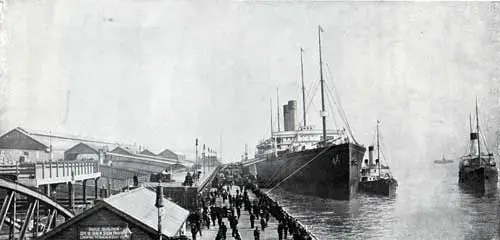
RMS Cedric, Twin-Screw, 21,000 Tons at the Liverpool Landing Stage.
His desire to change ships was soon realised when he is next listed aboard the SS Cedric, the second of a quartet of ships over 20,000 tons, dubbed "The Big Four," and the largest vessel in the world at the time of her launch, 21st of August 1902. RMS Cedric was a 21,035-gross register ton ship, 700 ft (210 m) long and 75 ft 3.6 in (22.951 m) abeam, with two funnels, four masts, two propellers and a service speed of 16 kn (18 mph). There was accommodation for 365 first-, 160 second- and 2352 third-class passengers, and a crew of about 350. Most importantly she was on the shorter North Atlantic route, commencing her maiden voyage from Liverpool to New York on 11th of February 1903. This was the only route on which she was ever used, although the Cedric was also sometimes used for winter cruises to the Mediterranean.

Wilde appears on the 11th of February 1903 crew agreement for the maiden voyage of the SS Cedric, under the command of Captain Herbert J Haddock. (Click image to enlarge)
This was a major setup for Wilde. He appears on the 11th of February 1903 crew agreement - notable in that this was the maiden voyage, under the command of Captain Herbert J Haddock; she arrived in New York after a successful voyage on the 20th of February. But it also meant a step down in role as he is listed as being demoted to Second Officer for all of the monthly voyages from Liverpool almost once a month from February 1903 through to November 1903.

An undated photograph described as R.M.S. Cedric in an "early 20th Century sepia-tone photograph depicting a crew muster or presentation with Captain and officers on an aft deck, mounted on card -- 11½ x 14¾in. (Christies Auction)
Cedric and the 'Titian' sinking rumour
The Cedric went on to have a career without any major incident. However in Wilde's final month aboard her as Second Officer, in November 1903, there was a rumour started in Liverpool that the Cedric had been "sunk in the mid-Atlantic by a collision with the Lamport and Holt steamer Titian.." The report was carried in the Friday, 27th of November, 1903 edition of The Times (London) stating: "There was a certain plausibility about the report, as the Cedric left Liverpool on November 18 for New York, and the Titian sailed on November 14 from New York for Manchester. The story was cabled to New York and thence returned here." However, the Titian arrived safely in Manchester, as did the Cedric in New York which "places beyond doubt the baseless character of the story." (The Times, Friday 27th November 1903.)
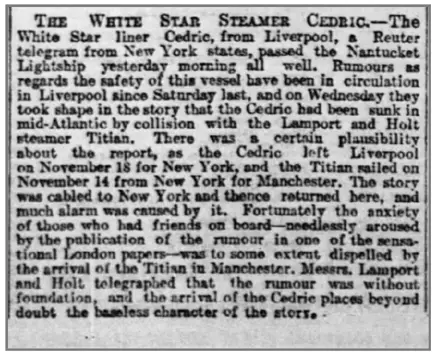
The Friday 27th November 1903 The Times story
on the Titian collision rumour.
Royal Naval training
At the beginning of 1904 he began his Royal Naval training. He is listed as aboard the HMS Defiance from the 4th of January 1904 until the 26th of February 1904. The HMS Defiance (shore establishment 1884) was the Royal Navy's torpedo school. So it is also not surprising that he is described as having " Torpedo training" as an acting lieutenant and receiving a 2nd class Torpedo certificate. In the RNR notes it states: "bearing and behaviour, sobriety and attention v.g. (very good). Recommended for training."
Then on the 29th of February until the 12th of April he was aboard the HMS Cambridge for "gunnery training" for which he received a 2nd class Gunnery certificate. The HMS Cambridge was a Royal Navy shore establishment south of Plymouth UK.
The HMS Cambridge was originally the HMS Windsor Castle a triple-decker, 102-gun first-rate Royal Navy ship Built in 1858. She was renamed HMS Cambridge in 1869, when she replaced a ship of the same name as gunnery ship off Plymouth.
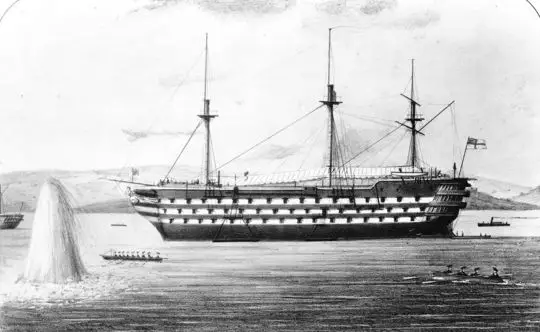
The HMS Cambridge firing a torpedo. Aboard this ship Wilde received his "gunnery training" in 1902.
He received his Torpedo certificate 2nd class on the 26th February 1904. This was followed by further training on the HMS Cambridge from the 27th of February 1904 unitl 22nd of April 1904, resulting in a 2nd class Gunnery certificate.
He was then briefly aboard the ships HMS Vivid and HMS Kent between the 23rd of April and 10th of May 1904, boarding HMS Endymion on the 11th of May for a total 7 months until the 30th of November 1904.
The HMS Endymion was a first-class protected cruiser of the Edgar class. His work aboard this cruiser was not without incident. In a letter to family he wrote that on August 8th, 1904 at 10.45pm they were involved in a collision with a Norwegian sailing ship named the Ruth:
"It happened on Monday night about 10.45pm. We left Penzance about 8 o'clock so as to get to a certain place to join p with the remainder of the Channel Fleet the next day for maneuvers. It was a fine, smooth sea and everything, but very dark when we collided with a Norwegian sailing ship. She did us quite a lot of damage but nothing like we did to her. If there had been more wind it would have been more serious. We stood by the ship and sent a boat to her to see what damage was done and they wanted to be towed into port. She did look a wreck... All our damage is above the water." (Sincerely Harry, Michael Beatty (63.))
The date was also of significance as the following day, on the 9th of August 1904, Henry Wilde became father to Henry Owen Wilde. His time aboard the Endymion ended successfully however, with the RNR documentation noting his "ability as OOW [Officer of the Watch] V.G [Very Good]".
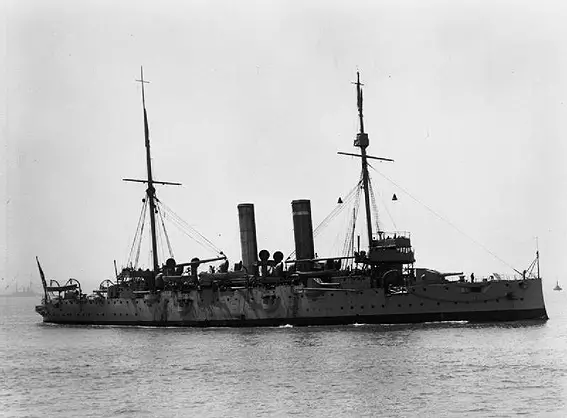
Wilde served aboard the HMS Endymion from May to November 1904, during which time he was involved in a collision with a sailing ship.
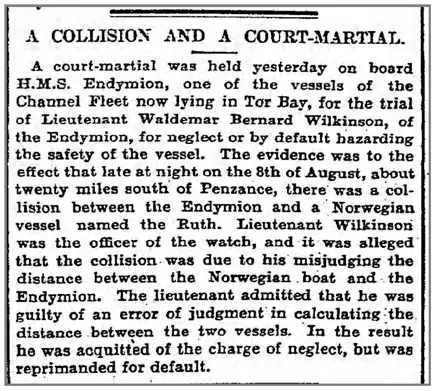
The Guardian of 18th August 1904 covers the Endymion collison and subsequent court-martial of Lieutenant Waldemar Bernard Wilkinson, who was Officer of the Watch and admitted an 'error of judgment'.
His spent the next five months from December 1904 until April 1905 aboard the HMS Cumberland, an impressive looking ship with three imposing smoke stacks. The HMS Cumberland was one of 10 Monmouth-class armoured cruisers built for the Royal Navy in the first decade of the 20th century. She was assigned to the 2nd Cruiser Squadron of the Channel Fleet upon completion in 1903. It was a very new ship and her complement consisted of 678 officers and enlisted men. His time aboard was well noted, the RNR documents stating: ""Satisfactory. An excellent officer, trustworthy."
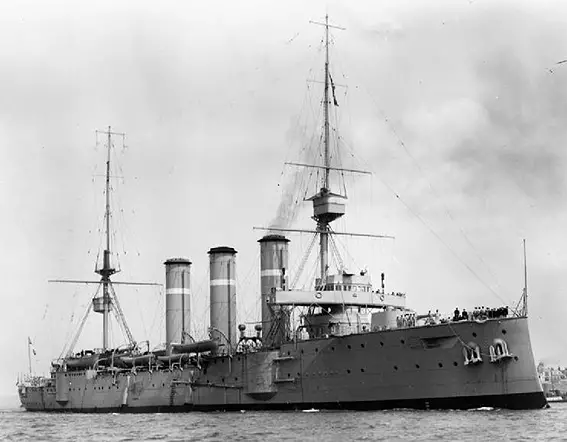
The HMS Cumberland was one of 10 Monmouth-class armoured cruisers built for the Royal Navy aboard which Wilde was described as "Satisfactory. An excellent Officer. Trustworthy & zealous. Sober & officer-like habits"
After leaving the HMS Cumberland he spent three days aboard the HMS Victory in April and is then next listed as returning to civilian duty as first officer aboard the SS Arabic on the Liverpool to Boston route, from the 3rd of June 1905 until the 28th of July 1905. During this voyage he was made a Lieutenant in the Royal Naval Reserve, officially listed on the 12th of June 1905.
The SS Arabic had entered service in 1903 as an ocean liner, originally on the New York route. But in April 1905 she was changed to the Boston route, which included stops at Queenstown, sailing alongside the Cymric and Republic for the next two years. Wilde worked aboard her as first officer on a regular basis from June through to November of 1905.
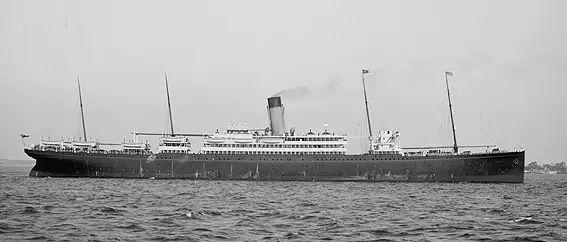
Wilde worked aboard the SS Arabic as first officer on a regular basis from June through to November of 1905. (Click image to enlarge)
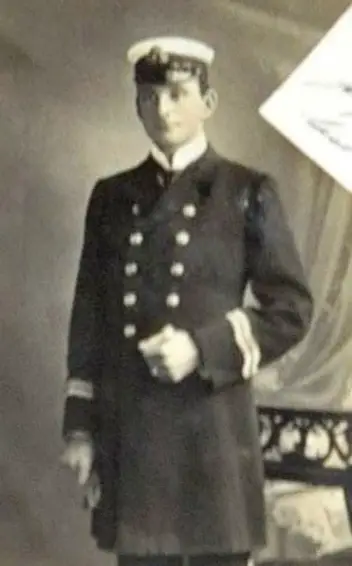
Henry Wilde in a First Officer's uniform. He was First officer aboard the SS Persic (1901/1902), SS Arabic (1906) and RMS Celtic (1906):
The Big Four and Australia
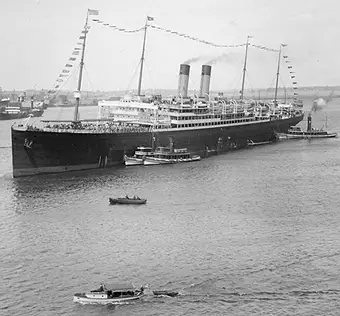
The RMS Celtic - Wilde was First Officer aboard the
Celtic 1905 - 1906.(Click to enlarge)
On the 15th of December 1905 Wilde changed ships to the RMS Celtic, which ran on the Liverpool to New York route, still in the capacity of First Officer. The Celtic was slightly older than the Arabic (1901) but it was larger - in fact it was the first ship larger than SS Great Eastern by gross register tonnage (it was also 9 feet (2.7 m) longer). The Celtic was the first of a quartet of ships over 20,000 tons, dubbed "The Big Four.""
Wilde embarked on a number of voyages aboard the Celtic from December 1905 through to April 1906, until he returned, perhaps reluctantly, to the Australia route once more aboard the Medic. The Medic was once again a slightly older ship (1899) but almost half the tonnage of the Celtic, built primarily for the Australia service.
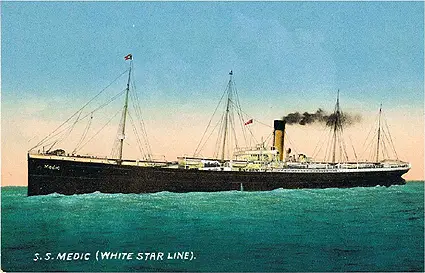
Postcard of the SS Medic. Wilde was promoted to Chief Officer aboard the Medic.
(Click image to enlarge)
He is listed as being aboard voyages on the Medic that departed Liverpool on the 8th of June 1906 not returning until the 15th of September 1906. It is during this time, on the 13th of August 1906 that George Arnold Wilde was born. A smaller ship on the much longer Australian run and missing the birth of his son may have appeared to be a negative turn in his career, however there was a positive effect: he was promoted to the role of Chief Officer aboard the Medic on that long June to September run. He is subsequently listed as Chief Officer on voyages aboard the Medic from February to June 1907, July to November 1907 and November 1907 to March 1908.
While Wilde was aboard in the capacity of Chief Officer, the Medic was involved in a collision, on the 15th of June 1907 when she collided with the 4,134 ton petroleum tank steamer Turbo in fog in the English Channel off the Kent coast while sailing from London to Liverpool. The Turbo was seriously damaged and had to be towed to harbour. The damage to Medic at first appeared to only consist of a crack above the waterline, and so she continued her voyage to Liverpool where she was dry docked for a more thorough examination of the damage. It was discovered that Medic had a 5 sq ft (0.46 m2) hole below the waterline; several lumber plates having been loosened and displaced.
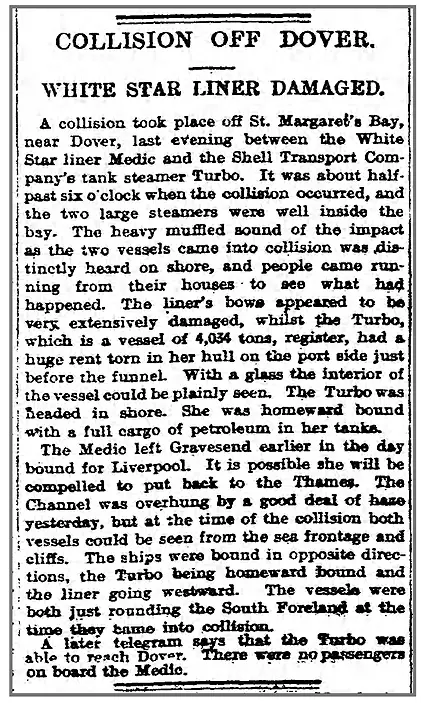
The Guardian of 15th of June 1907 reports the collision of the Medic
with a tanker, during the time Wilde was Chief Officer.
In March 1908 he thankfully returned to the Liverpool New York journey returning to the second of "The Big Four" White Star Line ships over 20,000 tons - the RMS Cedric. But this time he sailed aboard her as Chief officer from March 1908 through to April 1908. But by May he was back on the Medic, still as Chief officer on the Australia route once again.
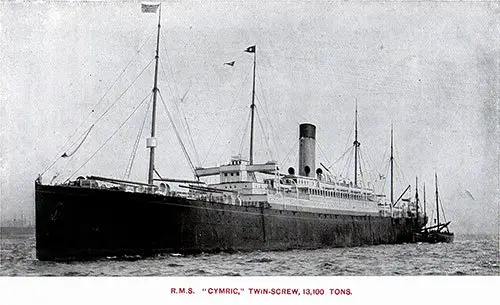
RMS Cymric. Wilde served aboard her
from March to April 1909 as Chief Officer.
Master of the Mersey?
Wilde's White Star Line record lists him as in "command" of the "Mersey" from the 4th of May 1908 until the 6th of June 1908. The Mersey was a three masted, 1,829 ton iron-hulled sailing ship. In 1908 the White Star Line purchased the ship for training 60 cadets making six voyages to Australia as a White Star training ship, traveling around the Cape of Good Hope outbound and Cape Horn inbound.

Wilde's White Star Line record clearly shows him listed in "command" of the "Mersey" from the 4th of May 1908 until the 6th of June 1908.
According to the The Times (London), 21 August 1908:
The Mersey was originally designed for carrying passengers. Her dimensions are---length, 271ft.; beam, 39ft.; tonnage, 1,829; and she is classed 100 A at Lloyd's. She is one of the finest type of British built sailing ships, and in rig she is an ideal craft for the purpose of training sailors, for she carries everything to stern sails. She has been specially fitted and altered to meet the requirements in view. There is excellent living accommodation for the cadets 'tween decks, and the school room is a spacious cabin on the main deck. In addition to obtaining practical experience in working a ship at sea, the boys will continue their general education, and will receive instruction in navigation, nautical astronomy, compass deviation, meteorology, marine surveying, charts, ship construction, stowage and assortment of cargo, care and management of boats, naval architecture,outfit and measurement of boats, charter parties, rudiments of marine engineering, and other branches of seamanship.
And there are further Titanic connections to this ship. The Mersey had been Herbert Pitman's (Titanic's Third Officer) first ship as an apprenticeship from the 19th of April 1895, listed as an Able-Bodied sailor until the 18th of April 1899. Also Titanic's Fifth Officer Lowe is listed as Chief Offcer, from 23.9.11 - 23.3.12. - although there is some doubt as to the certainty of this.
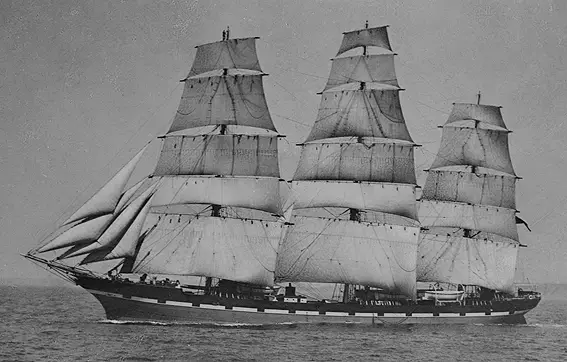
The full rigged ship Mersey in full sails. Credit: Allan C. Green/State Library of Victoria. (Click image to enlarge)
North Atlantic and Mediterranean
By March 1909 he had returned to the North Atlantic aboard the SS Cymric, a much older ship (1898) that had been on the New York route but since 1903 was transferred to the less travelled Liverpool-Boston route. Wilde served aboard her from March to April 1909 as Chief Officer before changing to the newer ocean liner, the SS Laurentic, that had only been launched a year before, and was on the Montreal run, with Wilde as Chief Officer. He served aboard her for two crossings in June and July 1909 before returning to the RMS Cedric for a run to New York on the 18th of September 1909, arriving in Liverpool on the 11th of October 1909.
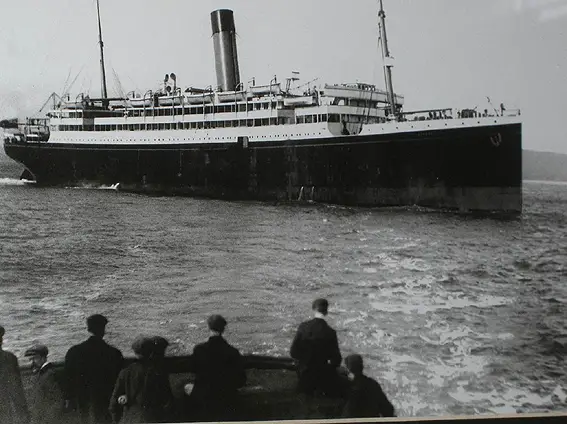
The SS Laurentic was on the Montreal run, with Wilde as Chief Officer. He served aboard her for two crossings in June and July 1909. (Click image to enlarge)
At the end of 1908 he joined the SS Canopic, a nine year old much smaller ship that was on the White Star Line's Mediterranean service. Wilde was once again Chief Officer.
From the 12 September 1908 to the 26 June 1909 he served under Captain Inman Sealby on the Canopic as her chief officer, voyaging to Italian ports such as Genoa. Among his shipmates on the Canopic was First Officer David Blair. Some years later he would possibly inadvertently save Blair’s life, as his appointment to the Titanic would result in Blair’s ‘bumping’ from the line-up of the Titanic’s deck officers. ("On Watch" - Nautical-papers.com, 2002 by Jemma Hyder and Inger Sheil)
During his time aboard the Canopic his daughter Nancy Annie was born in December 1908. But not all was fine with family. He received news that his father-in-law, Owen Jones, was in ill health (throat cancer) during 1909 and he touchingly asked Henry to be an 'Executor of the Will' - showing that he held his son-in-law in high esteem.
On the 9th March 1909 Henry wrote a letter from Naples while chief officer of the SS Canopic: "We sail from Naples tomorrow at 5pm with a big 3rd class list, but very few Saloon passengers. I think we have about 1200 3rd class and 200 2nd class and we also pick up another 200 at the Azores where we are due on the 16th. We are due at Boston on the 22nd but I don’t expect to be there until the early morning of the 23rd owing to the foul state of the ship underneath the water having been out of dry dock for nearly 7 months." (Sincerely Harry, Michael Beatty (63.))
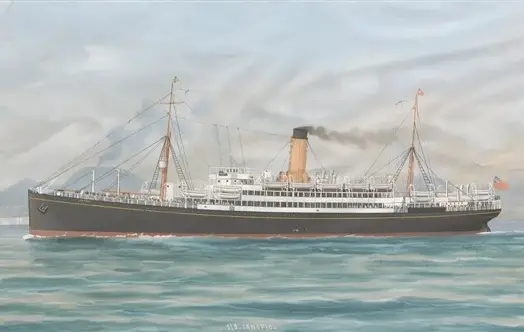
SS Canopic, artwork by Continental School, 20th Century
Sadly, on the 13th of April 1910, his father-in-law Owen Jones died. By October 1910 he was back on the North Atlantic route as Chief Officer of the Cedric on the Liverpool to New York voyages. He is listed as sailing regularly through the months of October and November. But shortly thereafter further tragedy was to strike at the family home of 25 Grey Road, Liverpool, which would have a profound effect on the life of Henry Wilde.